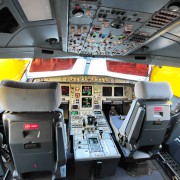My Captain and I were witnesses but also actors of a LOC-I situation (Loss Of Control In flight) at the end of a leg between Nuremberg (Germany) and Kuala Lumpur (Malaysia) in May, 2011.
We were very fortunate to finally land the aircraft safely and to be able to talk about this incident. We’d like to share our experience with you, while also highlighting how the flight training syllabus at ECAIR can prepare you for such an incident.
First, the details about the flight itself:
Aircraft: Falcon 7X
Crew:
- PF (Pilot Flying): right hand seat (RHS)
- PNF/PiC (Pilot Non Flying / Pilot In Command): left hand seat (LHS)
- Falcon 7X flying experience for both pilots : 80 hours
- CC (Cabin Crew): in the cabin
- No passenger on board (ferry flight)
Leg:
- NUREMBERG (EDDN) – Subang Kuala Lumpur (WMSA)
- Estimated time of flight : 12 hours
- Take-off weight: close to the MTOW (Maxium Take Off Weight) with 31200 lbs on board at take-off
- Take-off at 0809Z and estimated time of arrival (ETA) at 2010Z (0410AM Local time) with 2600 lbs on board
- Present weather when the incident happened : by night, VMC conditions, neither icing nor turbulence
Parameters when the incident occurred:
- Position : north of destination airfield for 40 Nm
- Aircraft descending to 11 000 ft Subang QNH at 300 kts, AP (Autopilot) and AT (Autothrottle) engaged
- Aircraft crossing 12 500 ft
When crossing 12 500 ft, without being warned by any fault message, the airplane instantaneously and violently nosed up because of a Tail Horizontal Stabiliser (THS) technical issue. The latter, for unknown reason, positioned itself to a full pitch up position leading up to a 40-degree attitude, a 4,6-g load factor and a slight right turn.
My first reflex was to counter the pitch up in pushing the stick forward (this action disconnected the AP) but, unfortunately, this action had no effect. Actually, the elevators, responsible for the aircraft pitch movement and located at the THS trailing edge, were hidden because of the THS present position. Simultaneously, I moved the throttles forward to the max power position (which disconnected the AT).
Without any pitch authority and realizing that the speed was decreasing rapidly (138 kts is the lowest recorded speed), my second reflex was to bank the aircraft to put its nose on the horizon as soon as possible in the shortest way. To fulfill my objective, and in spite of sluggish flight controls, I had to bank up to 100° by the right to stop the pitch up event.
As a matter of fact, no action around the roll axis would have left the aircraft climb …and, finally, on the top of this climb, the aircraft wouldn’t have stalled because of the fly-by-wire controls, but it would have fallen with an approximate 100-knot indicated airspeed and a high vertical speed component…and, remember, still without any pitch authority.
After levelling off the F7X with the nose on the horizon, my Captain took the controls and tried to understand what was happening. Then, a second pitch up occurred without, again, any specific reason (for the specialists in aeronautics, this second pitch up is due to the phugoid oscillation phenomenon that exits on an airplane pitch axis).
Eventually, on the top of the second pitch up curve, a safety device in charge of looking after THS movements set off and we recover the aircraft control.
Consequently, as we didn’t know at that time what the problem was, we manually flew the approach and the landing in Emergency. For your information, the airplane climbed up to 24000 feet which represents a 12000-foot altitude difference and the data recorder revealed that, from the first pitch up to the end of the second one, we had lost the pitch authority for 2’13’’ !
The aim of this report is not to find the reasons why this pitch trim runaway occurred, but rather to increase pilots and management staff’s awareness that this kind of extreme situation actually does happen.
Did my military background help me to keep the 7X under control ? (Note: Christophe Desilles is a former fighter pilot of the French Air Force) The answer is: Yes, it definitely did. Thanks to these reflexes, I managed to get out of this unusual situation. But don’t be mistaken, I have acquired these reflexes through dedicated training, and I’m convinced, that without this training, I would have not been able to react appropriately.
Having reviewed the ECAIR UPRT training syllabus in detail, I think it is geared to train pilots to be able to face exactly this type of situation.
Christophe Desilles
Former fighter pilot – French Air Force
Currently Captain of a Falcon 7X
 ECAIR Aviation is extremely proud to have provided to WIZZAIR Top training managers our specific UPRT” Train the trainer course” last month in Budapest…
ECAIR Aviation is extremely proud to have provided to WIZZAIR Top training managers our specific UPRT” Train the trainer course” last month in Budapest…



